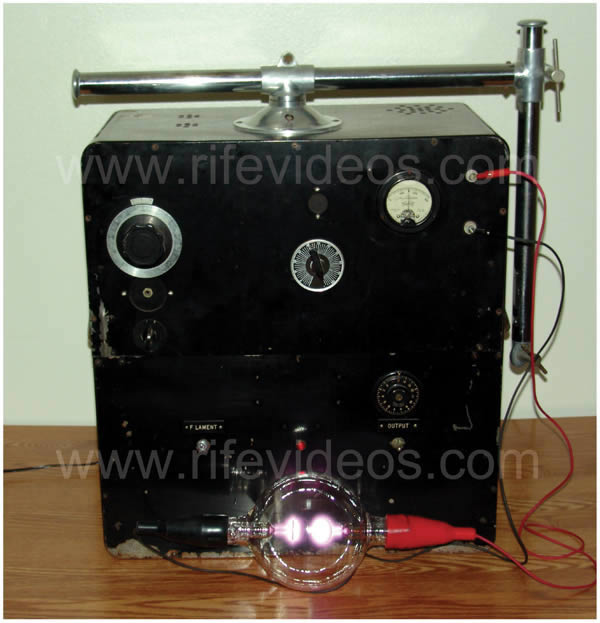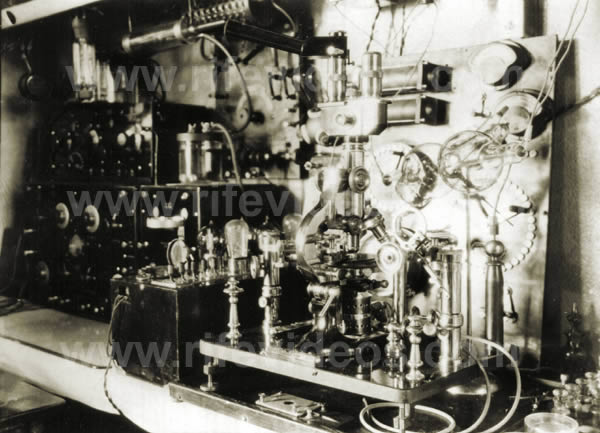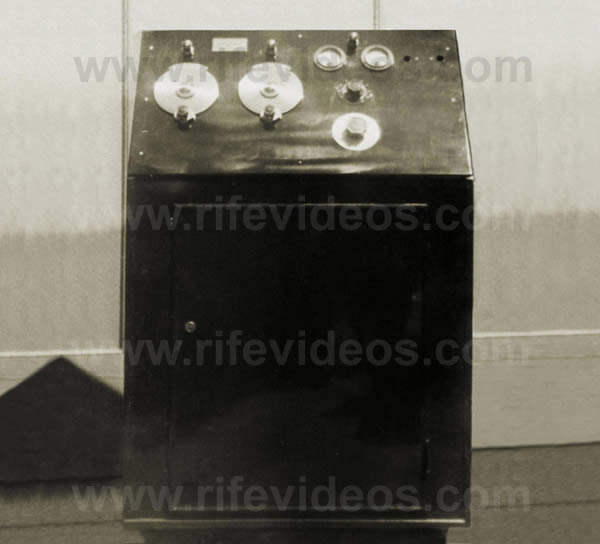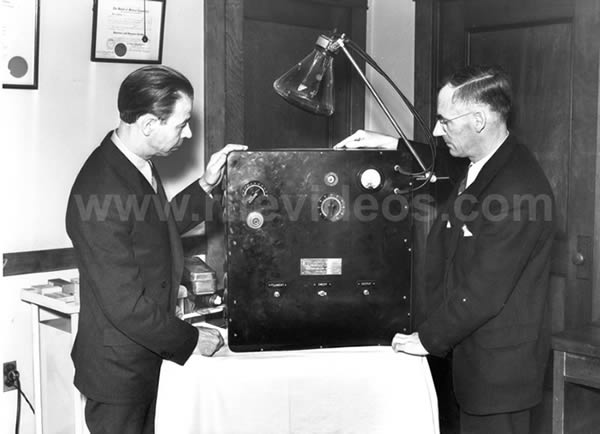| Home | Accessory Kit | Marsh CD Collection | Library | Contact Us |
Rife Machine Comparisons
 |
| Rife Ray #5 or Beam Ray Clinical Rife Machine. |
The information on this page was written for those who are looking to purchase a frequency generator and want it to have the capabilities that Dr. Rife's original machines had. Even after reading "The Rife Machine Report" many people are still confused about what features Dr. Rife's original equipment had. His equipment was very limited compared to today's technology but his frequency range was higher than 95% of today's so called "True Rife Machines." On this page we will cover the capabilities of the Rife Ray #3, Rife Ray#4 and the Rife Ray #5 or Beam Ray Clinical instrument. What Is A "True Rife Machine"?
|
 |
The photo shown above is of the Rife Ray #3. In the foreground, all the way to the right, you can see Dr. Rife's double bubble ray tube. Just to the left of the ray tube is his microscope which he used for finding the frequencies that would devitalize microorganisms. To the left of his microscope, over against the wall, we see his frequency generating equipment that made up the Rife Ray #3.
His frequency equipment consisted of the Kennedy model 110 connected to the Kennedy 525 audio amplifier. On top of the Kennedy model 110 we see the Kennedy model 281 which is connect by wires to the model 110. To the right of the Kennedy 525 audio amplifier we see another black box with vacuum tubes sticking out of it. This was Dr. Rife's 50 watt 5 stage RF amplifier.
Below are the specifications:
1. Output its frequencies through a Ray Tube at about 50 watts of power.
2. The Rife Ray #3 combined two Kenndy frequency generators together.
3. The frequency range of the Kennedy model 110 went from 12,000 Hertz to about 2,000,000 Hertz (2 Megahertz).
4. The Kennedy model 281 which is on top of the model 110 had a frequency range from about 475,000 Hertz to about 2 million Hertz.
5. When the model 110 and model 281 instruments were connected together it made it possible for Dr. Rife to output two high RF (Radio) frequencies at the same time. It also made it possible to modulate one low audio frequency starting from 12,000 Hertz onto a high RF carrier frequency which came from the model 281.
If you want learn all about the Rife Ray #3 then read Chapter 7 of "The Rife Machine Report." In order to duplicate the capabilities of this instrument you would have to have a frequency generator that had a frequency range from 12,000 hertz to 2 Million Hertz. Almost all of the so called "Rife Machines" on the market today that call their instrument "Rife Machines" only have a very low audio frequency range. They cannot output Dr. Rife's true frequencies. Some manufactures will mislead people into purchasing their machines by claiming that their machines use low audio frequency harmonics which will reach Dr. Rife's high RF frequencies through harmonics. It is impossible to do this but they manage to convince people that it is possible. The truth is if you want to run Dr. Rife's frequencies purchase a frequency generator that can output Dr. Rife's true frequencies.
Many instruments today used hand cylinders and foot plates. There is nothing wrong with using an instrument that uses this method. This method has worked very well for over 50 years. But many people know and understand that Dr. Rife used a Ray tube type of instrument.
Rife Ray #4
 |
The photo shown above is a picture of the Rife Ray #4. There were only two of these instruments built. The first was built in 1935 for Dr. Milbank Johnson M.D., and the second was built for Dr. Rife. This instrument was built after the 1934 clinical trial. Dr. Johnson wanted an instrument that was put into the comforts of a single cabinet. He also wanted an instrument that was able to handle the workload that the Rife Ray #3 could not do. What is interesting is the Rife Ray #4 was built without an audio oscillator which shows that Dr. Rife felt that this frequency range was no longer needed in his work.
Below are the specifications:
1. Output its frequencies through a Ray Tube with a variable power output up to 500 watts.
2. The Rife Ray #4 had two oscillators (frequency generators) that could output two high RF frequencies at the same time.
3. The Rife Ray #4 DID NOT have an audio oscillator and its frequency range went from 87,000 Hertz to 22,500,000 Hertz (22.5 Megahertz).
If you want to learn all about this instrument then read Chapter 8 of "The Rife Machine Report." In order to duplicate the capabilities of this instrument you would have to have a frequency generator that had a frequency range from 87,000 Hertz to 22.5 Megahertz (22,500,000 Hertz). The highest frequency that Dr. Rife had on any of his laboratory notes was in the 17 Million Hertz range so a frequency generator with a 20 Million Hertz range would cover all of the frequencies listed on any of Dr. Rife's laboratory notes.
Rife Ray #5 or Beam Ray Clinical Instrument
 |
The photo shown above is a 1938 photo of Dr. Rife (on the left) and Philip Hoyland (on the right) with the Rife Ray #5 or Beam Ray Clinical instrument. This instrument was put into three different cabinets but the internal design remained the same. The smaller cabinet, shown above, was a portable model which had two handles, one on each side. It weighed about 100 pounds and it usually took two people to move it. The larger cabinet models had four wheels on the bottom and could be rolled around by one person. The original instrument that was analyzed for "The Rife Machine Report" and found in Chapter 9 is shown in the photo at the top of this page.
This machine was the instrument that was used by all the doctors. It worked on a completely different principle than all the previous instruments that had been built. This instrument also had a new circuit design which was call a M.O.P.A. (Master Oscillator Power Amplifier). It had a fixed carrier frequency and used audio frequencies to produce high frequency sidebands to devitalize the microorganisms. The audio frequencies were not the frequencies which devitalize the microorganisms. The carrier frequency also did not devitalize the microorganisms. It was the combination of the audio frequencies and the carrier frequency which produced, through sidebands, the frequencies which would devitalize the microorganisms.
Below are the specifications:
1. Output its frequencies through a Ray Tube at about 50 watts of power.
2. It had an audio oscillator which covered a frequency range from 160 Hertz to 42,600 Hertz.
3. It had a fixed RF (Radio Frequency) carrier frequency of either 3.3 Megahertz (3,300,000 Hertz) or 3.8 Megahertz (3,800,000 Hertz).
4. It produced RF sideband frequencies which covered a range from 2.8 Megahertz to 4.3 Megahertz. All of the frequencies that devitalized organism were in this frequency range.
If you want to learn all about this instrument then read Chapter 9 of "The Rife Machine Report." In order to duplicate the capabilities of this instrument you would need to have a frequency generator that had a frequency range from 160 Hertz to 4.3 Megahertz (4,300,000Hertz). The frequency generator would also have to be able to produce nearly 100 high frequency harmonic sideband frequencies.
Because of the harmonics created from using a Ray Tube all three of these instruments could produce harmonic frequencies, with considerable power, to about 25 Megahertz (25,000,000 Hertz). In two of these instruments, the Rife Ray #3 and Rife Ray #5, this was the method used to produce Dr. Rife's high RF frequencies up in the 17 Megahertz (17,000,000 Hertz) Range. The Rife Ray #4 could produce those frequencies directly.
Conclusion
If these three instruments were combined into one instrument it would cover a frequency range from at least 160 Hertz to about 20 Megahertz (20,000,000 Hertz). Today there are frequency generators that have a frequency range from 1 Hertz to 20 Megahertz (20,000,000 Hertz). This type of frequency generator would require the use of hand-cylinders and footplates.
The Rife Ray #5 or Beam Ray Clinical instrument had a Ray tube which worked on a narrower band of frequencies. The Rife Ray #4 had several frequency bands that covered a very broad frequency range which was harder to operate than the Rife Ray #5 or Beam Ray Clincal instrument. To simplify the instrument Dr. Rife's engineer, Philip Hoyland, found that he could produce higher harmonics of Dr. Rife's frequencies, in this narrower band, by using an audio oscillator and a fixed RF carrier frequency. By doing this he made the Rife Ray #5 or Beam Ray Clinical ray tube instrument work better and also made it easier to operate by those doctors who used this instrument.
The Rife Ray #5 or Beam Ray Clinical instrument is the machine that was used by all the doctors from 1938 through the early 1960's. The Rife Ray #5 or Beam Ray Clinical instrument original vacuum tube RF circuit, even today, still cannot be duplicated in solid state electronics. The audio oscillator section of this instrument can be built better with modern solid state electronics but the RF section cannot. The RF section and the audio section are two different circuits. The RF section built with old vacuum tubes is superior to solid state electronics because of its ability to produce nearly a hundred sideband frequencies at the same time (Read here to see what sideband frequencies are capable of doing). This shows that sometimes modern technology still cannot produce what the old tube technology could do. The superiority of old vacuum tube technology is also evident in old vacuum tube audio amplifiers used by musicians to amplify their music. The new modern solid state audio amplifiers are inferior to the old vacuum tube amplifiers. And so it is with Dr. Rife's original vacuum tube ray tube instruments. Solid state cannot produce what the old vacuum tubes could do.
Today there are many Ray tube instruments on the market which are NOT RF (Radio Frequency) Ray tube instruments. They are called EM (Electro-Magnetic) Ray tube instruments. These instruments usually only have a frequency range that will go from 1 Hertz to about 20,000 Hertz. This frequency range can never produce Dr. Rife's true frequencies. You will have to ask those who sell Ray tube instruments specifically if their instrument can output variable RF frequencies through their ray tube. The easiest way for you to know if an instrument can output RF frequencies is to ask this simple question. Is your instrument an EM or RF instrument? If they tell you it is an EM Ray tube instrument you will know that it cannot output Dr. Rife's high RF frequencies. If they tell you it is an RF Ray tube instrument then you need to ask another question. Can your instrument output Dr. Rife's original high variable RF frequencies from the 139,200 Hertz to 1,607,450 Hertz or the upper harmonics of these frequencies in the three million (3,000,000) Hertz range which were used in the Rife Ray #5 or Beam Ray Clinical instrument? If they tell you no, then keep looking. When looking for a Ray Tube instrument make sure it can produce an RF carrier frequency in the two (2,000,000) to three million (3,000,000) Hertz range. Also ask if the RF carrier frequency can produce multiple harmonic sidebands (up to 100). Then it will work like the Rife Ray #5 or Beam Ray Clinical instrument or M.O.P.A (Master Oscillator Power Amplifier). There is no modern solid state ray tube instrument on the market today that can do this. Only the old vacuum tube technology can produce nearly a hundred harmonic sideband frequencies. There is a company that builds a replica of this style of vacuum tube instrument. For companies that sell equipment that will work in the frequency ranges that we have mentioned. Click here for that information.
| Want to know how to make any frequency generator with the proper frequency range and power output work like a Rife Machine click here. |
